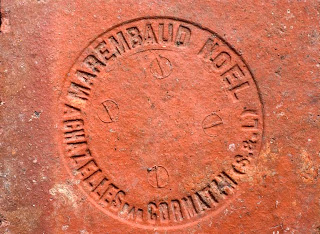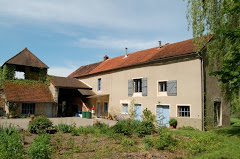 It may be clear by now that we live in a tuilerie; to be more precise, in La Tuilerie de Chazelle. Chazelle is a small hamlet and part of the community of Cormatin. When we came here, we thought that a tuilerie was a roof tile factory. However, we found out that at least in in this part of Burgundy a tuilerie does more than just making roof tiles. Actually, we are not even sure whether this factory has ever produced any roof tiles at all. We have found numerous floor tiles, rectangular bricks and wedge shaped bricks with the inscription of the founder of the factory “Marembaud Noël, Chazelles, Cormatin, S&L”, but we have never found a single roof tile amongst the rubble where we found the others.
It may be clear by now that we live in a tuilerie; to be more precise, in La Tuilerie de Chazelle. Chazelle is a small hamlet and part of the community of Cormatin. When we came here, we thought that a tuilerie was a roof tile factory. However, we found out that at least in in this part of Burgundy a tuilerie does more than just making roof tiles. Actually, we are not even sure whether this factory has ever produced any roof tiles at all. We have found numerous floor tiles, rectangular bricks and wedge shaped bricks with the inscription of the founder of the factory “Marembaud Noël, Chazelles, Cormatin, S&L”, but we have never found a single roof tile amongst the rubble where we found the others.The founder of this factory, Monsieur Noël Marembaud, lived from 1855 to 1936. The previous owner of La Tuilerie de Chazelle, the grand daughter of Monsieur Marembaud, told us that the factory stopped production in 1924; then it was turned into a small holding. If we assume that the guy started his factory at the age of 30, the factory must have been producing bricks and floor tiles over a period of approx. 40 years.
Tuileries are usually located near a river (because of nearby clay sediments, in our case from the river Grosne), outside a village (because of the smoke pollution) and at the edge of a forest (because of the availability of fire wood). In the area here, which houses a number of rivers, such as the Grosne, the Guye, the Grison and the Saône, there are quite a number of old tuileries to be found, some in good shape, others completely run down. Some photographs of the various tuileries in the vicinity can be found on the following web page. Some Tuileries in S&L (71)
How did a tuilerie work? The clay was dug from a nearby quarry with shovels, and transported to the place where the clay was mixed. The clay mixer was a big barrel with a heavy mixer, which was propelled by horse power. When the clay, after adding water if necessary, had achieved the right consistency, the clay was formed into bricks by a brick press (one at a time!). After the bricks were formed, they were stored on a sand bed in the séchoir or drying shed. These séchoirs were usually long, low open buildings, where the wind had free play in order to dry the bricks naturally. The bricks were ready to go into the oven, when the sound they produced whilst the artisan was hitting one brick with the other had the right pitch.
 the "four" or kiln is a very primitive “furnace”; it is usually a tall square tower with a roof, and big ventilation holes right underneath the roof. The walls are very thick. The kiln of La tuilerie the Chazelle has inside dimensions of 2.75 x 3.15 m (9’ x 10’-6”) and 1.8 m (6’) thick walls. The total height is approx. 10 m (34’), and the distance between grade level and the underside of the smoke or ventilation holes is approx. 5.5 m (18’). A kiln has two entrances. The lower entrance at grade level is approx 70 cm (2’- 4”) wide and 1.75 m (6’) high; the higher entrance lies opposite the lower one at 1.75 m (6’) up to 3.5 m (12’) and is 1.75 m (6’) high as well. Obviously they used the lower entrance when starting stacking the bricks up to a level of 1.75 m (6’). After having filled up most of the kiln area up to this height, they could not access the kiln any more from this entrance, and hence the filling continued through the second entrance up to a level of 3.5 m (6’). Once this level was reached, ladders were place outside the kiln against the walls, and the last layers of bricks or tiles were lowered from above through the ventilation holes. With regards to the stacking, there was one peculiarity. It was not enough to stack the bricks in such away that there were gaps between the bricks.
the "four" or kiln is a very primitive “furnace”; it is usually a tall square tower with a roof, and big ventilation holes right underneath the roof. The walls are very thick. The kiln of La tuilerie the Chazelle has inside dimensions of 2.75 x 3.15 m (9’ x 10’-6”) and 1.8 m (6’) thick walls. The total height is approx. 10 m (34’), and the distance between grade level and the underside of the smoke or ventilation holes is approx. 5.5 m (18’). A kiln has two entrances. The lower entrance at grade level is approx 70 cm (2’- 4”) wide and 1.75 m (6’) high; the higher entrance lies opposite the lower one at 1.75 m (6’) up to 3.5 m (12’) and is 1.75 m (6’) high as well. Obviously they used the lower entrance when starting stacking the bricks up to a level of 1.75 m (6’). After having filled up most of the kiln area up to this height, they could not access the kiln any more from this entrance, and hence the filling continued through the second entrance up to a level of 3.5 m (6’). Once this level was reached, ladders were place outside the kiln against the walls, and the last layers of bricks or tiles were lowered from above through the ventilation holes. With regards to the stacking, there was one peculiarity. It was not enough to stack the bricks in such away that there were gaps between the bricks.Our kiln has two tunnel shaped openings in the walls at ground level (which are now bricked up, but clearly visible). The first stones where stacked in such a way, that they formed a tunnel from the fire tunnels in the wall to the wall on the other side. Once the two tunnels were formed, the stacking continued the normal way. The bricks were stacked first, on top of the bricks the floor tiles were stacked, on top of those came the roof tiles, and the highest layer consisted of lumps of lime stone. Once the kiln was filled up, the entrances were bricked up and the fires were lit. The fire tunnels were filled up with faggots, and when these burned well, the fire was fed with logs and finally with coal. The whole process took about a month, from loading, firing, cooling to unloading. The capacity of our tuilerie was very small.
 Assuming that the production consisted of bricks only, each cycle produced approx. 16000 bricks. Winter was used to get wood from the forest, but of course no clay could be dug from the quarries. there were possibly only four cycles per year. However, most houses in this area are built of stone, and bricks were mainly used for decoration around door and window openings. Hence the supply of bricks was possibly more or less equal to the demand.
Assuming that the production consisted of bricks only, each cycle produced approx. 16000 bricks. Winter was used to get wood from the forest, but of course no clay could be dug from the quarries. there were possibly only four cycles per year. However, most houses in this area are built of stone, and bricks were mainly used for decoration around door and window openings. Hence the supply of bricks was possibly more or less equal to the demand.As far as we know there is still one traditional tuilerie active in Bourgogne. The Tuilerie de la Chapelle de Sarre in Corbigny, Nièvre (58) still produces wood fired bricks, floor tiles and roof tiles. The factory has worked uninterrupted for 250 years. The old kiln however, although still in tact, has been replaced by a four room kiln, where the production is circulating continuously. Hence there is always one room being loaded and heated up, one fired, one is cooling down, and the last one is being unloaded. And although a proper factory, and not a tourist attraction, we were given a very interesting guided tour by one of the friendly workers there.
Click here to read the continuation.
The website of La Tuilerie de Chazelle


No comments:
Post a Comment